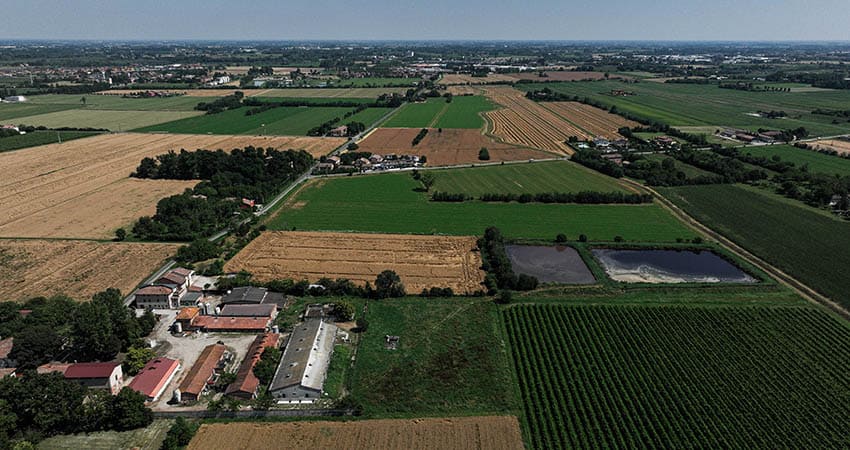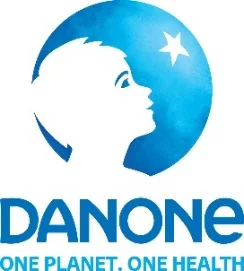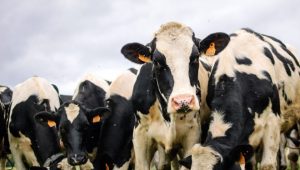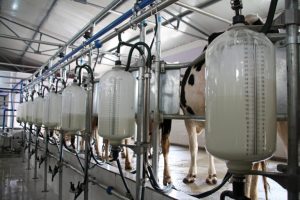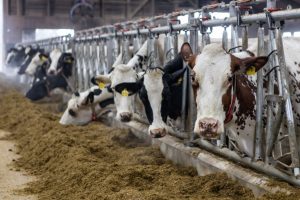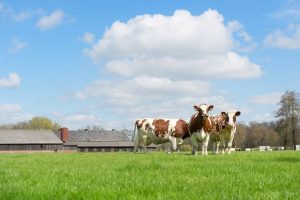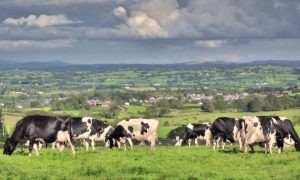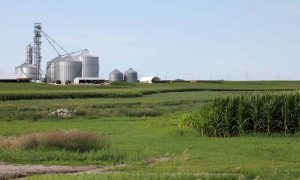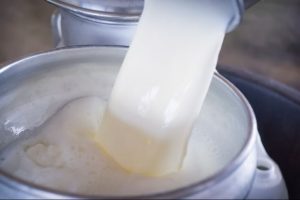
Eutrophication of surface waters and exceeded nitrate norms in groundwater. That is the result of discharging vast amounts of manure and slurry by intensive dairy farms in Lombardy, Italy. The European Union started an infringement procedure against the Member State. Investigative journalist Cecialia Fasciani discloses what is going on. Her article is the last long read in a series of three about the impact of the intensive dairy industry on water quality.
One and a half million cows are found in the Lombardy region in Italy, out of a total of approximately six million, one out of four. In the region today, there are more than 16,000 cattle farms. Among the Lombardy provinces, the lead goes to Brescia, which accounts for 28% of the farms and 32% of the heads of cattle. Emilia-Romagna, where more than half a million cows are located, follows closely in the rankings behind the Lombardy region, after Veneto and Piemonte. In the province of Modena alone, which shares its border with the Lombardy region, the number of cows is around 100,000, while the number of pigs is around 350.000.

Monocultures invade every metre of farmland in Mantua, Photo: Cecilia Fasciani.
Hotspot Lombardy
“In Lombardy, between cattle and pigs, almost 23 tonnes of manure are produced annually, which is about six times the weight of the region’s urban solid waste production. What was once considered ‘the gold’ of the fields has now become waste”, explains Damiano Di Simine, spokesperson for the scientific committee of Legambiente Lombardia. Indeed all these animals, concentrated in a relatively small space, eventually produce the famous ‘Italian excellences’, meat, cold cuts and cheeses, but they also generate huge quantities of a by-product that is increasingly difficult to manage, manure. From this point of view, bovines are the most impactful animals, with significantly more tonnes of manure produced per year. Di Simine’s remarks that “according to European legislation, manure is not waste if it can be used according to good agronomic practice. Therefore, manure does not qualify as waste if it is used for what is commonly referred to here as ‘fattening the fields’, i.e. giving nutrients, organic substance, nitrogen, phosphorus and potassium to crops”. However, in our country’s dominant system of intensive farming, so many liquid effluents are produced “that farmers in many cases find it challenging to treat and manage”. As many scientific resources have explained, excessive spreading of animal manure on the land leads to a specific pollution, that of nitrates, which leach from the soil into the water. According to the World Health Organisation, nitrate concentrations above the standard of approximately 9 mg/l for groundwater and 18 mg/l for surface water (depending on soil type and rainfall) are almost always attributed to livestock farming activities or the heavy use of nitrogen fertilisers that are washed away by rainfall and transferred into the water, carried by the groundwater run-off.
Nitrate concentrations above the norm
In water intended for human consumption, the legal limit for nitrates is 50 milligrams per litre. According to the United States Environmental Protection Agency (EPA), regulatory limits are already too high to effectively protect newborns. In fact, the maximum level to protect newborns up to 6 months of age should remain below 10 mg/l, because they still lack the enzyme necessary to counter the effects of excessive ingestion. According to various scientific studies, nitrates, once ingested by the human body, are reduced to nitrites, which, when they encounter other chemical substances found in foods, react to form nitrosamines, which can have potentially carcinogenic consequences. At high concentrations, once nitrates are transported into the circulatory system, they can cause an abnormal increase in methaemoglobin, which may compromise the oxygen supply to tissues, endangering children in particular. A Danish study found nitrates in groundwater and drinking water may increase the risk of colon and rectal cancer. In 1991, to protect waters from pollution caused by agricultural nitrates, the European Union approved the Nitrates Directive. The limits set by the Directive are quite precise: every farmer must have an agronomic plan for their fertilisers and slurries, and they cannot use more than 340 kilograms of nitrogen per hectare, that corresponds to the nutritional requirements of crops. In sensitive zones (ZVN), where there is, for example, a risk of nitrogen leaching into the water table, this threshold is halved: no more than 170 kilograms of nitrogen per hectare may be used. Member States are required to implement water monitoring programs with specific timelines across the entire national territory. In Italy, the directive was transposed into the Legislative Decree of 2006, which states that the Italian regions are the administrations responsible for implementing the obligations of the Nitrates Directive.
Groundwater pollution
The issues of nitrates and the unsustainability of certain forms of agriculture have been topics of discussion for years. Institutions are aware of the damage these issues cause the waters of these regions, nevertheless there don’t seem to be signs of a willingness to change course or, more to the point, to hold those who feel exempt from accountability in check. And today, as the situation is further worsening due to ongoing climate change and the reduction of water flow rates in the rivers, the most affected regions, such as Lombardy, are requesting additional exemptions to raise the legal thresholds even in vulnerable areas.
Dumping slurry systematically
It is precisely in the triangle between Brescia, Mantua and Cremona, where the highest density of livestock farms is to be found, that the problem of nitrate concentrations in surface and groundwater is well above the parameters allowed by the European Directive. “What concerns us most in the case of surface waters are the eutrophication processes, which involve a significant decrease in oxygen and fish mortality, the cascading effects of which extend all the way to the Adriatic. While with regard to groundwater, our main concern is the impact of nitrates on human health. If we take all this into account, the situation is very serious because almost everywhere in the Po Valley we are well over the 10 mg/l threshold for nitrates, and it is not uncommon to exceed the 50 mg/l threshold. This is a major issue”, warns Di Simine. Particularly in the Lombardy region, where the density of adult bovine units (ABU) per hectare is around 2.8 – 3, there is no adherence to the maximum limits allowed by the Directive, which are identified as around 1.5 to at most 2. “In areas with a high intensity of livestock farming, on a municipal basis, even 5-6-7 ABU per hectare are measured, which is completely out of proportion with respect to the capacity of crops to absorb nitrogen”. These are the essential legal conditions, but according to the complaints collected by Di Simine, not only are the limits often exceeded, but there are frequent cases of completely illegal practices: “Farmers, taking advantage of a moment when inspections are not taking place, open the bottom of the tank, and all the slurry ends up in the near irrigation ditch. I have a chronology of such events that is endless. Unfortunately, they happen systematically, especially in the Brescia, Mantua and Cremona plains”, he continues.
Complaint about derogation
Damiano Di Simine is among those who, in 2019, directly approached the European Commission after the Lombardy region decided to seek derogations from the Nitrates Directive and its Italian transposition decree. This stipulates, among other things, that slurry cannot be spread for 90 days in the winter period, and for 60 continuous days from December 1st to January 31st. “The winter use of slurry has no justification, because it means using a fertiliser in the absence of crops”, Di Simine explains. “In 2019, it rained heavily from October to December, and when it rains, it’s obvious that you cannot spread manure on the ground because it would leach much more quickly into the groundwater. On that occasion, the Italian Ministry of Agriculture sent a note to the regions, stating that they had found ways to allow spillage windows even in winter. As soon as we saw this communication, we wrote to the European Union”, continues the scientific coordinator of Legambiente. The Lombardy region, being the most affected, not only decided to use the derogation options granted by the Ministry of Agriculture, but even to incorporate these into their own transposition regulation: instead of the 60 days stipulated in the national decree, in the Lombardy region, the continuous period of prohibition is still limited to 30 days to this day. “The European Union took us very seriously. Although it was archiving the Italian violation, after this report it reactivated the procedure”, Di Simine continues.
Infringement Procedure
More recently, in February 2023, the European Commission sent a reasoned opinion to Italy (the second step in infringement procedures-INFR. 2018-2249), for failing to comply with the EU Directive (Directive 91/676/EEC) and to better protect its waters from pollution caused by nitrates from agro-livestock sources. If the Ministry of Agriculture, Food Sovereignty and Forestry does not take the necessary measures, the Commission could decide to refer our country to the Court of Justice of the European Union, with the risk of significant sanctions that would affect the entire population.
Subsidized pollution
But these contradictions also concern the EU as a whole. During the plenary session on July 11th 2023, the EU Parliament voted to exclude bovine farming from the directive on industrial emissions, thus rejecting the proposal that the Commission had presented in April 2022 in preparation for the text revision. Only pig farms with more than 2,000 heads or 750 sows, and poultry farms with more than 40,000 heads remain within the scope of the legislation, marking a significant change in perspective compared to the European Green Deal. Furthermore, the misallocation of European Common Agricultural Policy (CAP) funds has been brought to light in a comprehensive study by Greenpeace of the Lombardy region. According to Greenpeace’s Investigative Unit, out of the over 250 million euros that in 2018 were allocated to livestock farms in Lombardy, as much as 120 million (almost 45%) ended up in the 168 municipalities that the Lombardy region reports as areas where the legal nitrogen load has been exceeded. In the documents, it is also revealed that the 40 Lombardy municipalities where livestock farms received the most funding all fall within Sensitive Zones (ZVN), and over 80% of these municipalities exceeded the nitrogen load limit. “So, European Union funds continue to primarily finance those livestock farms located in municipalities that exceed the annual nitrogen limit per hectare,” explains Federica Ferrario, Greenpeace’s Agriculture Campaign manager. Additionally, according to the Lombardo Silvia Information System, Greenpeace observes that between December 2018 and January 2020 at least 10 projects for the expansion or construction of new farms were approved in 33 of these municipalities. A figure that is underestimated because it does not include smaller projects that do not enter the regional and provincial evaluation system.

Irrigation drives pollution
Even during unbearably hot summer days, Marco Bartoli, a professor at the University of Parma and an aquatic ecologist who has always been concerned with the chemical quality of water, travels to the area south of Lombardy, in the province of Mantua. Here he conducts water quality surveys of the rivers flowing in these areas, which from the large lakes of northern Italy end up feeding the country’s longest river, the Po. “What we are doing today, in comparison to traditional knowledge, is linking the issue of intensive livestock farming, fertilisation and field irrigation with ongoing climate change and the resulting reduction in river water flow”, reveals the professor, who knows by heart the roads and lanes that branch off in the lower Mantua region, where monocultures of corn invade every inch of farmland. Sometimes, he leaves his car by the roadside to venture onto small trails through the fields and reach stretches of the river hidden from most people’s view.

Large quantities of water taken from the river Mincio and used for irrigation in the fields. Photo: Cecialia Fasciani.
“Agriculture in Italy is heavily irrigated, with over 50,000 kilometres of man-made canals built over the last five centuries; canals which have facilitated the distribution of water taken from the rivers and ensured it reached every agricultural plot. This is what has allowed this widespread prosperity”, Bartoli explains. The professor begins his journey by studying the waters near the sea, but then moves back inland, where he believes the origins of the problem lie. He has formed a research group to specifically analyse the water of these rivers. Given the number and density of livestock reared in these areas, it is quite shocking not to see a single one grazing as the professor stops several times to take samples at different points of the Mincio riverbed. However, of this same water used for irrigation, only a small amount is taken up by the plants, while the majority returns to the rivers. “The chemical quality on the way there and on the way back is completely different. Rivers originating from the large Alpine lakes are among the cleanest and highest quality in all of Europe, as is the Mincio. But its waters, used to irrigate fields with a significant excess of nitrogen, return to the riverbed with a nitrate concentration that is ten times higher than when they left”, the professor continues. “If, on the other hand, irrigation occurs on very gravelly soil, this water percolates vertically, contaminates the groundwater, and accumulates there”. This process is referred to as the “irrigation loop“: “nitrate is, by definition, a traveller through water, and here a vicious cycle is created where irrigation acts as a driving force for pollution.
Climate change exacerbates nitrate pollution
“Our research group’s history began by chance with the monitoring of the Mincio and Oglio rivers. When we put the data together, we saw an entirely unnatural step-like graph emerge. Nitrates always tend to increase in rivers, but there is no natural river that is made up of steps, and climate change is exacerbating this process”. And we are now in a new phase, “because this water is available differently than in the past”, the professor explains. The thirst of an agriculture that was born and grew up with an abundant availability of irrigation means that rivers are increasingly being drained, with the building upstream of diversions that take most of the water volume. The Mincio, for example, has points where it almost runs dry.
Eutrophication and Research to plan future interventions
With regard to aquatic environments, a point of reference is most certainly the Department of Life Sciences and Systems Biology at the University of Turin. Here professors and students carry out their research, and are also protagonists of the Alpstream project: an analysis of the impact of climate change, and in particular drought, on the ecological status of Alpine rivers. In 2020, the District Basin Authority of the Po River (ADBPO) commissioned a study on the dynamic origin of pollutant loads, such as nitrogen, in the basin of the river Po, which is being concluded in these weeks by the universities of Turin, Parma, and Ferrara. Francesca Bona, a biology professor at the University of Turin, coordinated part of this study: “Eutrophication is a process that can occur in aquatic ecosystems when there is an excessive input of nutrients, i.e. the compounds that are needed for the growth of aquatic plants and algae. The goal was to quantify precisely the loads of nitrogen and phosphorus from the basin that lead to eutrophication, and which then, from the various rivers, go on to determine a final load in the Adriatic Sea. It may come as a surprise, but it is not so simple that these calculations are known basin by basin, whereas it is absolutely important for the district authority to know this, for the planning of future interventions”.
Livestock hotspots extra polluted
Daniele Nizzoli, on the other hand, is a professor at the Department of Chemical, Life and Environmental Sustainability Sciences at the University of Parma, and he is also part of the project commissioned by ADBPO. His research group conducted an initial analysis of the quantities of these elements used in the area, and some fairly clear consequences are noticeable. “In surface waters, the variation in nitrate concentration is quite evident between mountain and lowland areas – there being an increase in livestock density and what we call pressure on the land i.e. more cultivation and use of fertilisers in the latter”, explains Nizzoli. Therefore, it is not a problem that occurs uniformly across the entire Po Valley. In itself, eutrophication might seem like a positive phenomenon: there is more richness, more biomass. “But the problem is that when this enrichment is excessive, the growth is also excessive, and so the ecosystem can no longer cope. This can lead to oxygen deficiency, and the consequences on aquatic ecosystems can be quite severe”, explains Professor Bona.
Flow reduction complicates achieving WFD-goals
This research appears to complement the studies conducted by Professor Bartoli, because the influence of climate change is always there to disrupt the balance. Traditionally, eutrophication has mainly affected coastal areas, or lakes – those slow ecosystems characterised by limited water turnover, which promotes nutrient accumulation. “But what we have been witnessing for some years is that eutrophication is also returning to rivers, particularly in the northern regions of Italy and the Po Basin, where the invigorating action of the current is somewhat lacking. This is linked to climate change because it is raising the temperature and reducing the amount of water available in the rivers, causing a decrease in the strength of their currents. There is a strong link that has to be further investigated”, Francesca Bona continues. The Water Framework Directive of 2000, adopted in Italy in 2006, imposed various objectives on member states, setting out a scale with four categories: high, good, sufficient and poor. “The first objective was to achieve at least a good ecological status in all water bodies by 2015. Since this was not achieved, it has been postponed over time”, explains the professor. The next deadline is 2027, “but we are still a long way off, and it’s quite a challenge to meet”, she concludes.

Researchers study effect of eutrophication at the university of Turin. Photo: Cecilia Fasciani.

Professor Francesca Bona with her researchers at the university of Turin. Photo: Cecilia Fasciani.
Biodiversity disappeared
Arriving in the southern part of the city of Modena, in Emilia-Romagna, one’s gaze even here loses itself in an expanse of cultivated fields. Crossing narrow roads amidst crops and livestock barns, a strange odour strikes one’s nostrils, an odour that constantly accompanies those who live in these areas. The Modenese Section of Doctors for the Environment ISDE (International Society of Doctors for the Environment) was founded by a small group of doctors in the region who joined forces to deepen and disseminate scientific knowledge about the environment. From this informal group of experts, an active citizenship movement was then created, and together they decided to analyse the well water in an area located nearby Modena municipality, between Cittanova, Baggiovara, Cogneto, and Marsaglia (which falls under the Vulnerable Zone, ZVN). Dr Eva Rigonat, a veterinary doctor and expert in health legislation, has been actively involved in monitoring and reporting violations in the agricultural sector for years. She is a member of the association’s board of directors: “This is a small community; we who live here have known each other for a lifetime, and we’ve witnessed the transformation of the countryside over the last thirty years. Where there used to be immense biodiversity there is now only corn, alfalfa, sorghum, or wheat, to justify the spreading of all this slurry”.
Well nitrate concentrations are above the norm
From the report produced by the ISDE collective, it can be seen that out of the 16 wells analysed, only two fall below the limit of 50, while all the others have significantly higher levels, with a peak of 122 mg/l. “We did it using officially recognised methods, the same as the protocols of the Regional Agency for Environmental Protection (ARPA)”, Dr Rigonat says. It’s curious that the only well included in the regional monitoring network of ARPA Emilia-Romagna, the “reference well” in zone MO69-00, records levels of 25-26 mg/l. Furthermore, on page 32 of ARPA’s latest report, published in 2016, it is explicitly stated that “[…] (from 1994 to 2016), denotes an extension of the area with high Nitrate concentration towards the middle plain, highlighting a qualitative degradation of groundwater”. The Cognento and Marzaglia aquifers are home to the wells that supply most of the drinking water for the Modena aqueduct managed by Hera, the company that provides energy, water, and environmental services to about 4 million citizens. Hera’s data stated in its bills give an average concentration for the Modena municipal waterworks of between 23 mg/litre and 21 mg/litre, i.e. above the threshold recommended by the EPA for newborns up to 6 months of age.

This is the area of the Municipality of Modena where the water samples were taken from the 16 wells. The MO69-00 well is located 0.1-1 km from the nitrate-polluted wells. The dot marked in yellow would turn red or purple if one of the other wells in the area were monitored and you would have, thus a more realistic picture of the situation.
No data on individual farms and Lack of monitoring
After various research efforts regarding the livestock registry and requests for access to data from local institutions, the research group was only able to obtain a summary table from the Modena Local Health Authority (AUSL) with the total numbers of cattle and swine, and not the data for each farm. Moreover, the research group also noticed discrepancies in the tables of the General Urban Plan of the Municipality, adopted on December 22, 2022. Although Formal Observations had been submitted during the adoption phase, no changes were made to the tables where some important agricultural companies are located. Where there should be an indication of those structures, they appear to be completely absent. Additionally, next to it there are two enormous open-air ponds of 23,840 square metres, referred to as “water basins” in the Urban Plan. Furthermore, the Municipal document doesn’t mention the “Fossa degli Orsi”, a minor watercourse that passes just a few metres away from these lakes of animal waste. The pigsty is only 5 km away from the historic centre of Modena, raising concerns about how many other farms in Modena or the region may have been underestimated: “this is a very serious omission. At our urging, the town planning councillor replied that ‘mistakes can happen’. However, we strongly reject this. It is unacceptable because veterinary services have a legal obligation, consistently enforced in Emilia-Romagna, to provide a census of all farms to the national database in Teramo. So, the question is a political one: as an urban planning service, where do you obtain your data? You can’t take refuge behind the technicians”, Rigonat denounces. How is it that slurry storage ponds of such dimensions are still allowed in an environmental situation that is potentially so hazardous for residents, and in an area where public aquifers are recharged? “The technical-scientific data available so far and the contingent data from the analysis of the wells in this report demonstrate, once again, that action must be taken at the source of the problem: reducing the number of animals, especially in vulnerable zones. Checks on spillage or spreading of slurry are mostly done after direct complaints from citizens, but after having spoken with institutions several times and reported violations to control agencies such as ARPAE without having received substantial answers, it seems very difficult to imagine how the monitoring system currently in place can work”, the doctor continues. “At this point, it seems reasonable to deduce that the regulations fail to defend public health sufficiently. The principle of subsidiarity, which states to use the expertise of those closest to the problem, in this case the population, is being completely harassed by the administrations and therefore also by the technical bodies,’ accuses Eva Rigonat. And to make coherent and detailed reports, citizens must be well acquainted with both the territory and the regulations governing spreading or spilling. Additionally, large livestock companies often carry out such activities after dark so as to avoid drawing attention, while ARPA Emilia-Romagna does not provide a night control service.

Effluents stored in large ponds nearby a minor watercourse. Photo: Cecilia Fasciani.
Action needs to be taken
Despite these complaints from researchers or citizens specialised in the field, the Northern Italian regions continue to ignore the various alarm bells ringing in the area. In the meantime, in early August 2023, the Regional Council of Emilia-Romagna effectively removed the Regional Environmental Agency’s right to express opinions on municipal urban plans: it will no longer need to express an opinion on Strategic Environmental Assessments (VAS). Representing a significant step backward, the agencies will no longer be able to limit damage during the planning and construction phases. Instead of strengthening the technical staff of the agencies responsible for environmental control and protection on the ground or tightening urban planning regulations, once again, there is simplification and exemption, effectively undermining Strategic Environmental Assessment, an important control mechanism mandated by the European Union. “A great deal of evidence indicates that in order to comply with the Paris Agreement and avoid environmental and climate disaster, it is necessary to drastically reduce the production and consumption of meat and dairy products in favour of diets based more on plant-based products”, warns Greenpeace’s Ferrario. “In the 1960s, we consumed around 20-21 kilos of meat per year per capita, now we have reached almost 80. In Italy we should promote the many high-quality, small-scale production units to make them even more sustainable and resilient to future crises. Now is the time to act to produce less and better in terms of the quality of the environment, food and also the working conditions of the agricultural sector”.
